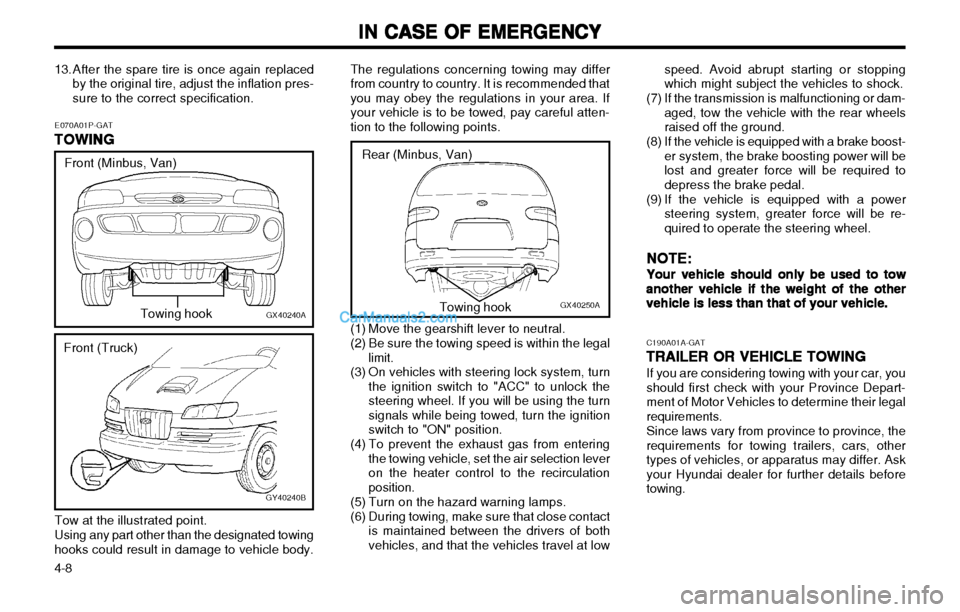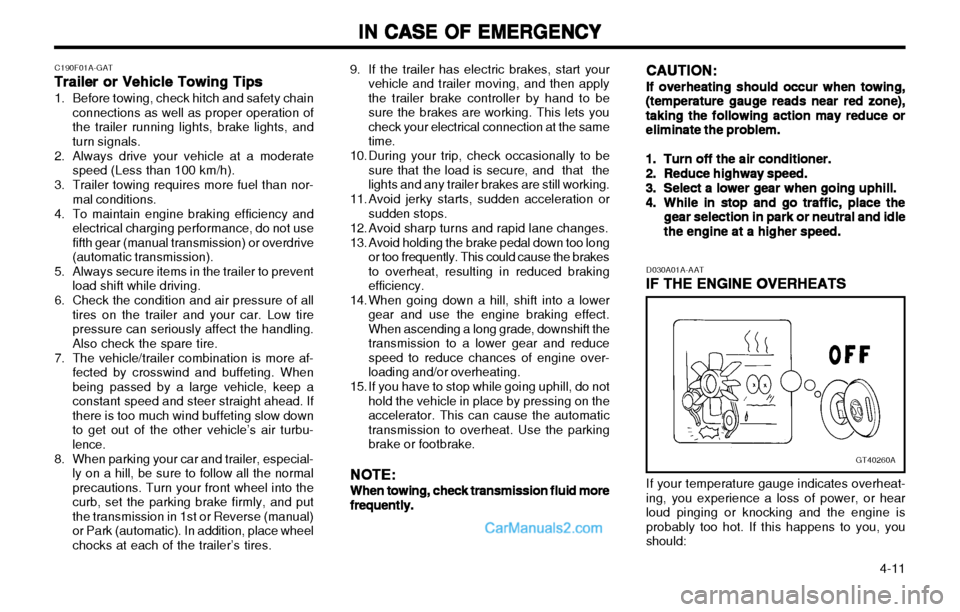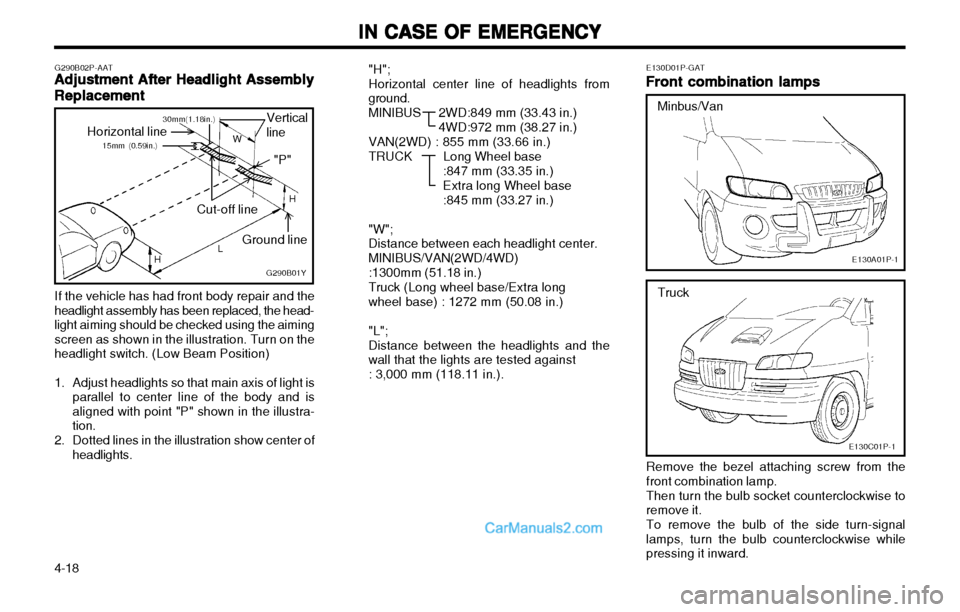2003 Hyundai H-1 (Grand Starex) turn signal
[x] Cancel search: turn signalPage 123 of 173

IN CASE OF EMERGENCY
IN CASE OF EMERGENCY IN CASE OF EMERGENCY
IN CASE OF EMERGENCY
IN CASE OF EMERGENCY
4-8 The regulations concerning towing may differ from country to country. It is recommended thatyou may obey the regulations in your area. Ifyour vehicle is to be towed, pay careful atten-tion to the following points.
C190A01A-GATTRAILER OR VEHICLE TOWING
TRAILER OR VEHICLE TOWING TRAILER OR VEHICLE TOWING
TRAILER OR VEHICLE TOWING
TRAILER OR VEHICLE TOWING
If you are considering towing with your car, youshould first check with your Province Depart-ment of Motor Vehicles to determine their legal requirements.Since laws vary from province to province, the requirements for towing trailers, cars, othertypes of vehicles, or apparatus may differ. Askyour Hyundai dealer for further details beforetowing.
GX40250A
Rear (Minbus, Van)Towing hook
(1) Move the gearshift lever to neutral.
(2) Be sure the towing speed is within the legal limit.
(3) On vehicles with steering lock system, turn the ignition switch to "ACC" to unlock the steering wheel. If you will be using the turnsignals while being towed, turn the ignitionswitch to "ON" position.
(4) To prevent the exhaust gas from entering the towing vehicle, set the air selection leveron the heater control to the recirculationposition.
(5) Turn on the hazard warning lamps.
(6) During towing, make sure that close contact is maintained between the drivers of both vehicles, and that the vehicles travel at low speed. Avoid abrupt starting or stoppingwhich might subject the vehicles to shock.
(7) If the transmission is malfunctioning or dam- aged, tow the vehicle with the rear wheelsraised off the ground.
(8) If the vehicle is equipped with a brake boost- er system, the brake boosting power will belost and greater force will be required todepress the brake pedal.
(9) If the vehicle is equipped with a power steering system, greater force will be re-quired to operate the steering wheel.
NOTE:
NOTE: NOTE:
NOTE:
NOTE:
Your vehicle should only be used to tow
Your vehicle should only be used to tow Your vehicle should only be used to tow
Your vehicle should only be used to tow
Your vehicle should only be used to tow another vehicle if the weight of the other
another vehicle if the weight of the other another vehicle if the weight of the other
another vehicle if the weight of the other
another vehicle if the weight of the other
vehicle is less than that of your vehicle.
vehicle is less than that of your vehicle. vehicle is less than that of your vehicle.
vehicle is less than that of your vehicle.
vehicle is less than that of your vehicle.
E070A01P-GAT
TOWING
TOWING TOWING
TOWING
TOWING
GX40240A
Front (Minbus, Van)
Towing hook
Tow at the illustrated point. Using any part other than the designated towing
hooks could result in damage to vehicle body.
GY40240B
Front (Truck)
13. After the spare tire is once again replaced
by the original tire, adjust the inflation pres- sure to the correct specification.
Page 126 of 173

IN CASE OF EMERGENCY
IN CASE OF EMERGENCY IN CASE OF EMERGENCY
IN CASE OF EMERGENCY
IN CASE OF EMERGENCY
4-11
9. If the trailer has electric brakes, start your
vehicle and trailer moving, and then apply the trailer brake controller by hand to besure the brakes are working. This lets you
check your electrical connection at the sametime.
10. During your trip, check occasionally to be sure that the load is secure, and that thelights and any trailer brakes are still working.
11. Avoid jerky starts, sudden acceleration or sudden stops.
12. Avoid sharp turns and rapid lane changes.
13. Avoid holding the brake pedal down too long or too frequently. This could cause the brakes to overheat, resulting in reduced brakingefficiency.
14. When going down a hill, shift into a lower gear and use the engine braking effect.When ascending a long grade, downshift the
transmission to a lower gear and reducespeed to reduce chances of engine over-
loading and/or overheating.
15. If you have to stop while going uphill, do not hold the vehicle in place by pressing on theaccelerator. This can cause the automatictransmission to overheat. Use the parkingbrake or footbrake.
NOTE:
NOTE: NOTE:
NOTE:
NOTE:
When towing, check transmission fluid more
When towing, check transmission fluid more When towing, check transmission fluid more
When towing, check transmission fluid more
When towing, check transmission fluid more frequently.
frequently. frequently.
frequently.
frequently. CAUTION:
CAUTION: CAUTION:
CAUTION:
CAUTION:
If overheating should occur when towing,
If overheating should occur when towing, If overheating should occur when towing,
If overheating should occur when towing,
If overheating should occur when towing,(temperature gauge
(temperature gauge (temperature gauge
(temperature gauge
(temperature gauge
reads near red zone),
reads near red zone), reads near red zone),
reads near red zone),
reads near red zone),
taking the following action may reduce or
taking the following action may reduce or taking the following action may reduce or
taking the following action may reduce or
taking the following action may reduce or
eliminate
eliminate eliminate
eliminate
eliminate
the problem.
the problem. the problem.
the problem.
the problem.
1.1.
1.1.
1. Turn off the air conditioner.
Turn off the air conditioner. Turn off the air conditioner.
Turn off the air conditioner.
Turn off the air conditioner.
2.2.
2.2.
2. Reduce highway speed.
Reduce highway speed. Reduce highway speed.
Reduce highway speed.
Reduce highway speed.
3.3.
3.3.
3. Select a lower gear when going uphill.
Select a lower gear when going uphill. Select a lower gear when going uphill.
Select a lower gear when going uphill.
Select a lower gear when going uphill.
4.4.
4.4.
4. While in stop and go traffic, place the
While in stop and go traffic, place the While in stop and go traffic, place the
While in stop and go traffic, place the
While in stop and go traffic, place the
gear selection in park
gear selection in park gear selection in park
gear selection in park
gear selection in park or neutral and idle
or neutral and idle or neutral and idle
or neutral and idle
or neutral and idle
the engine at a higher speed.
the engine at a higher speed. the engine at a higher speed.
the engine at a higher speed.
the engine at a higher speed.
C190F01A-GAT
Trailer or Vehicle Towing Tips
Trailer or Vehicle Towing Tips Trailer or Vehicle Towing Tips
Trailer or Vehicle Towing Tips
Trailer or Vehicle Towing Tips
1. Before towing, check hitch and safety chain
connections as well as proper operation of the trailer running lights, brake lights, andturn signals.
2. Always drive your vehicle at a moderate speed (Less than 100 km/h).
3. Trailer towing requires more fuel than nor- mal conditions.
4. To maintain engine braking efficiency and electrical charging performance, do not usefifth gear (manual transmission) or overdrive(automatic transmission).
5. Always secure items in the trailer to prevent load shift while driving.
6. Check the condition and air pressure of all tires on the trailer and your car. Low tirepressure can seriously affect the handling.
Also check the spare tire.
7. The vehicle/trailer combination is more af- fected by crosswind and buffeting. Whenbeing passed by a large vehicle, keep aconstant speed and steer straight ahead. Ifthere is too much wind buffeting slow downto get out of the other vehicle’s air turbu-lence.
8. When parking your car and trailer, especial- ly on a hill, be sure to follow all the normalprecautions. Turn your front wheel into the
curb, set the parking brake firmly, and putthe transmission in 1st or Reverse (manual)or Park (automatic). In addition, place wheel
chocks at each of the trailer’s tires. D030A01A-AAT
IF THE ENGINE OVERHEATS
IF THE ENGINE OVERHEATS IF THE ENGINE OVERHEATS
IF THE ENGINE OVERHEATS
IF THE ENGINE OVERHEATS
GT40260A
If your temperature gauge indicates overheat-
ing, you experience a loss of power, or hear loud pinging or knocking and the engine isprobably too hot. If this happens to you, youshould:
Page 131 of 173

IN CASE OF EMERGENCY
IN CASE OF EMERGENCY IN CASE OF EMERGENCY
IN CASE OF EMERGENCY
IN CASE OF EMERGENCY
4-16 A bulb should only be replaced with a new bulb of the same rating and type. The designationcan be found on the base of the bulb. Headlight, upper/lower beam ................ 60/55WFront turn-signal lamps ................................ 21WPosition lamps ............................................... 5WRear turn-signal lamps ................................. 21W Reversing lamps .......................................... 21W Licence-plate lamps ....................................... 5WStop and tail lamps ................................. 21/5WFront fog lamp .............................................. 55WSide repeater lamp ....................................... 5WRear fog lamp ............................................ 21W
E130D01P-1
Truck
E130B01P-1
E130C01P-1
Truck
Minibus/Van
E130B01P-GAT Bulb capacity
Bulb capacity Bulb capacity
Bulb capacity
Bulb capacity
E130A01P-1
Minibus/Van
E130A02P-GAT
REPLACEMENT OF LAMP BULBS
REPLACEMENT OF LAMP BULBS REPLACEMENT OF LAMP BULBS
REPLACEMENT OF LAMP BULBS
REPLACEMENT OF LAMP BULBS
Before replacing a bulb, be sure the light is off.
Do not touch the glass part of the new bulb with your bare fingers; the skin oil left on the glasswill evaporate when the bulb gets hot and thevapor will condense on the reflector and dim thesurface.
CAUTION:
CAUTION: CAUTION:
CAUTION:
CAUTION:
Keep the lamps out of contact with petro-
Keep the lamps out of contact with petro- Keep the lamps out of contact with petro-
Keep the lamps out of contact with petro-
Keep the lamps out of contact with petro- leum product, such as oil, gasoline, etc.
leum product, such as oil, gasoline, etc. leum product, such as oil, gasoline, etc.
leum product, such as oil, gasoline, etc.
leum product, such as oil, gasoline, etc.(2)(2)
(2)(2)
(2)
Never use a fuse with a capacity larger
Never use a fuse with a capacity larger Never use a fuse with a capacity larger
Never use a fuse with a capacity larger
Never use a fuse with a capacity larger
than that specified or any substitute, such
than that specified or any substitute, such than that specified or any substitute, such
than that specified or any substitute, such
than that specified or any substitute, such
as wire, foil, etc.;doing so will cause the
as wire, foil, etc.;doing so will cause the as wire, foil, etc.;doing so will cause the
as wire, foil, etc.;doing so will cause the
as wire, foil, etc.;doing so will cause the
circuit wiring to heat up and can cause a
circuit wiring to heat up and can cause a circuit wiring to heat up and can cause a
circuit wiring to heat up and can cause a
circuit wiring to heat up and can cause a
fire.fire.
fire.fire.
fire.
Page 133 of 173

IN CASE OF EMERGENCY
IN CASE OF EMERGENCY IN CASE OF EMERGENCY
IN CASE OF EMERGENCY
IN CASE OF EMERGENCY
4-18 E130D01P-GAT
Front combination lamps
Front combination lamps Front combination lamps
Front combination lamps
Front combination lamps
Remove the bezel attaching screw from the front combination lamp. Then turn the bulb socket counterclockwise to remove it. To remove the bulb of the side turn-signal lamps, turn the bulb counterclockwise whilepressing it inward.
E130A01P-1
Truck
Minbus/Van
E130C01P-1
"H"; Horizontal center line of headlights from ground.
MINIBUS 2
WD:849 mm (33.43 in.)
4WD:972 mm (38.27 in.)
VAN(2WD) : 855 mm (33.66 in.)
TRUCK Long Wheel base
:847 mm (33.35 in.) Extra long Wheel base:845 mm (33.27 in.)
"W"; Distance between each headlight center. MINIBUS/VAN(2WD/4WD):1300mm (51.18 in.)Truck (Long wheel base/Extra longwheel base) : 1272 mm (50.08 in.) "L"; Distance between the headlights and the wall that the lights are tested against : 3,000 mm (118.11 in.).
If the vehicle has had front body repair and the
headlight assembly has been replaced, the head- light aiming should be checked using the aimingscreen as shown in the illustration. Turn on theheadlight switch. (Low Beam Position)
1. Adjust headlights so that main axis of light is parallel to center line of the body and is aligned with point "P" shown in the illustra-tion.
2. Dotted lines in the illustration show center of headlights.
G290B02P-AAT
Adjustment After Headlight Assembly
Adjustment After Headlight Assembly Adjustment After Headlight Assembly
Adjustment After Headlight Assembly
Adjustment After Headlight Assembly
Replacement
Replacement Replacement
Replacement
Replacement
G290B01Y
Vertical line
Cut-off line Ground line
Horizontal line
LW
H
H "P"
15mm (0.59in.)30mm(1.18in.)
Page 155 of 173

CONSUMER INFORMATION
CONSUMER INFORMATION CONSUMER INFORMATION
CONSUMER INFORMATION
CONSUMER INFORMATION
8-6 I040A01P-GAT
Vehicle Interior
Vehicle Interior Vehicle Interior
Vehicle Interior
Vehicle Interior
The following should be checked each time when the vehicle is driven:
o Light operation
o Windshield wiper operation
o Horn operation
o Defroster, heater operation (and air condi- tioning, if equipped)
o Steering operation and condition
o Mirror condition and operation
o Turn signal operation
o Accelerator pedal operation
o Brake operation, including parking brake
o Manual transmission operation, including clutch operation
o Automatic transmission operation, including "Park" mechanism operation
o Seat control condition and operation
o Seat belt condition and operation
o Sunvisor operation
If you notice anything that does not operate correctly or appear to be functioning correctly,inspect it carefully and seek assistance fromyour Hyundai dealer if service is needed. Adequate care of your vehicle at regular inter- vals serves to preserve the value and appear-ance as long as possible. Some maintenance items can be carried out bythe owner (Consumer Information), while othershould be done only by an authorized dealer(Periodic Inspection and Maintenance). Thissection describes only those items which canbe carried out by the owner. In the event amalfunction or other problem is discovered,have it corrected by an authorized HYUNDAIdealer. This section contains information oninspection maintenance procedures that youcan do yourself, if you so desire. Follow theinstructions and cautions for each of the vari-ous procedures. When checking or servicing the inside of the engine compartment, be sure the engine isstopped and has had a chance to cool down. Ifit is necessary to do work in the engine com-partment with the engine running, be especiallycareful that your clothing, hair, etc., becomesnot caught by the fan, V-belts, or other movingparts. I050A01P-GAT
Inspection items
Inspection items Inspection items
Inspection items
Inspection items
( 1 ) Engine oil
( 2 ) Engine coolant
(3) Battery
( 4 ) Brake fluid
( 5 ) Clutch fluid (hydraulic clutch only)
( 6 ) Washer fluid
( 7 ) Wheel condition (including spare wheel)
(8) Tire inflation pressure (including spare
wheel)
I020A02P-GAT
GENERAL CHECKS
GENERAL CHECKS GENERAL CHECKS
GENERAL CHECKS
GENERAL CHECKS
Engine Compartment
Engine Compartment Engine Compartment
Engine Compartment
Engine Compartment The following should be checked regularly:
o Engine oil level and condition
o Transmission fluid level and condition
o Brake fluid level
o Clutch fluid level
o Engine coolant level
o Windshield washer fluid level
o Accessory drive belt condition
o Coolant hose condition
o Fluid leaks (on or below components)
o Power steering fluid level and condition
o Tire pressure and condition (including spare)
o Battery condition I030A02P-GAT
Vehicle Exterior
Vehicle Exterior Vehicle Exterior
Vehicle Exterior
Vehicle Exterior The following should be checked monthly:
o Overall appearance and condition
o Wheel condition and wheel nut tightness
o Air cleaner filter condition
o Exhaust system condition
o Light condition and operation
o Windshield glass condition
o Wiper blade condition
o Paint condition and corrosion
o Fluid leaks
o Door and hood lock condition
Page 172 of 173

INDEX
INDEX INDEX
INDEX
INDEX
10-4 SPARE TIRE ANTI-THEFT DEVICE
.................................................... 4-5
SPARE WHEEL ............................................................................. 4 - 4 ~ 4 - 5
SPEEDOMETER ........................................................................................ 2-5
SRS AIRBAG SYSTEM ........................................................... 1-29 ~ 1-32
SRS (Airbag) SERVICE REMINDER INDICATOR ........................2-10
STARTING THE ENGINE ....................................................................... 3-2
STARTING AND STOPPING THE ENGINE FOR TURBO CHARGER OR TURBO CHARGER INTERCOOLER .................. 3-3
STEERING WHEEL FREE PLAY ......................................................8-13
STEERING WHEEL TILT LEVER ......................................................1-29
STEREO RADIO AND CASSETTE TAPE PLAYER OPERATION (K220) .............................................................. 2-33 ~ 2-36
STEREO RADIO AND CASSETTE TAPE PLAYER OPERATION (H240, K240) ..................................................2-37 ~ 2-40
STEREO RADIO AND CASSETTE TAPE AND COMPACT DISC
PLAYER OPERATION (H280) ............................................2-48 ~ 2-54
STEREO RADIO AND COMPACT DISC PLAYER
OPERATION (H260) .............................................................. 2-41 ~ 2-47
SUNROOF ................................................................................... 2-19 ~ 2-20
SUN SHADE ............................................................................................ 2-19
SUN VISOR .............................................................................................. 2-20
T TACHOMETER ........................................................................................... 2-5
TAILGATE WINDOW WASHER FLUID LEVEL .............................8-12
TAILGATE WIPER AND WASHER SWITCH .................................2-13
TAILGATE .................................................................................................... 1-9
THEFT-ALARM SYSTEM ........................................................ 1-10 ~ 1-11THERMOMETER
....................................................................................... 2-7
THIRD SEAT ............................................................................... 1-20 ~ 1-21
TIRE INFLATION PRESSURE ............................................................ 8-13
TOOLS AND JACK ................................................................................... 4-1
TOWING ....................................................................................................... 4-8
TRAILER OR VEHICLE TOWING ..........................................4-8 ~ 4-11
TRANSAXLE FLUID .................................................................................. 9-4
TURN-SIGNAL INDICATION LAMPS-GREEN .................................. 2-9
TURN-SIGNAL SWITCH ....................................................................... 2-11
TWIN SWING DOOR ............................................................................ 1-14
V VENTILATION .......................................................................................... 2-25
VEHICLE IDENTIFICATION NUMBER (VIN) ..................................... 1-2
W WATER TEMPERATURE GAUGE ....................................................... 2-6
WHEEL CONDITION ............................................................................. 8-12
WHEEL ROTATION ............................................................................... 8-15
WINDSHIELD WASHER FLUID LEVEL ...........................................8-12
WINDSHIELD WASHER ....................................................................... 2-12
WINDSHIELD WIPER AND WASHER SWITCH ...........................2-12